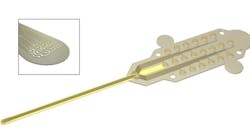Research published in 2D Materials demonstrates the performance of neural probes with integrated graphene field-effect transistors when measuring brain activity. The findings show improved spatial resolution at targeted regions. Minimal interference between probes enabled a high signal-to-noise ratio, even placed very close together.
In addition to monitoring brain activity, the probes could potentially be used to create complex sensory interfaces used in a range of brain therapies and technologies. For example, they could be used in brain-stimulation treatments, or be used to make up complex networks that send motion-control signals from the brain to artificial limbs.
The researchers implanted the graphene-based neural probes onto the brains of rats. They measured large pre-epileptic signals, as well as smaller signals generated during sleep. Soft and flexible, the graphene probes were engineered to be compatible with the brain's surface to minimize inflamation and rejection.
"Graphene is one of the few materials that allows recording in a transistor configuration and simultaneously complies with all other requirements for neural probes such as flexibility, biocompability, and chemical stability,” First author Benno Blaschke from TU Munich says. “Although graphene is ideally suited for flexible electronics, it was a great challenge to transfer our fabrication process from rigid substrates to flexible ones. The next step is to optimize the wafer-scale fabrication process and improve device flexibility and stability."
